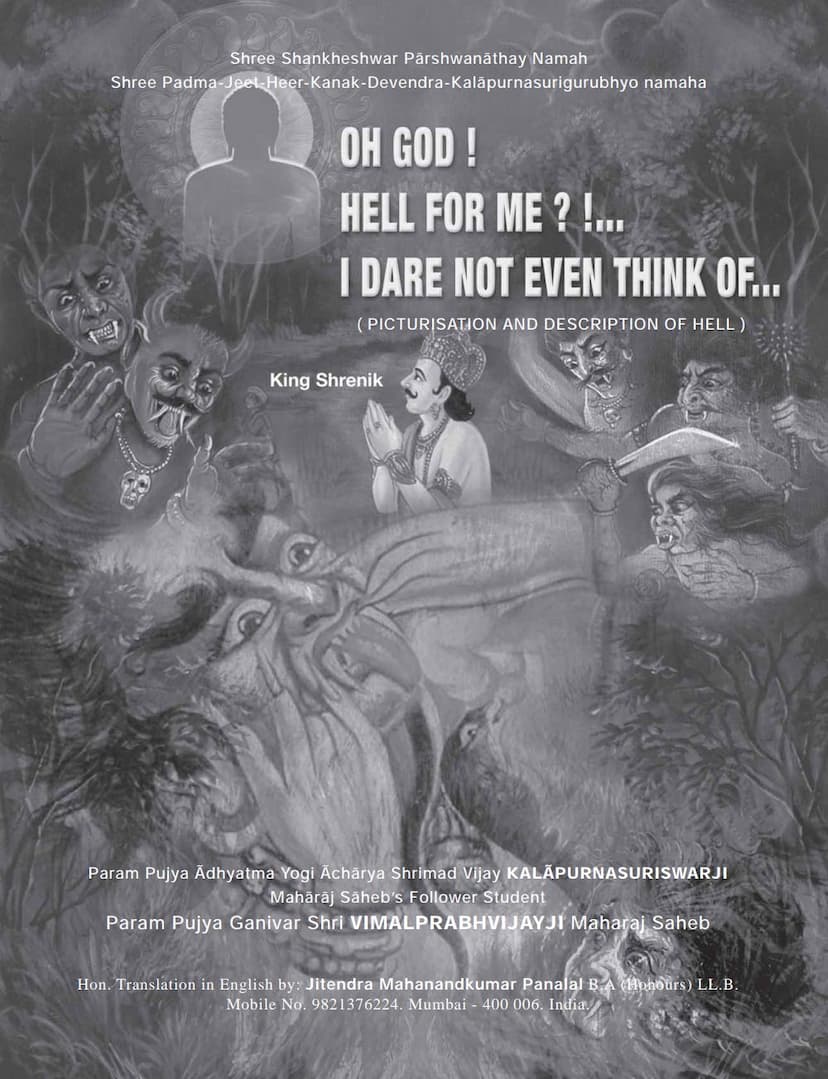Hell For Me I Dare Not Even Think Of
Added to library: September 1, 2025

Summary
This comprehensive Jain text, titled "Hell for Me I Dare Not Even Think Of," compiled by Param Pujya Ganivar Shri Vimalprabhvijayji Maharaj Saheb and translated into English by Jitendra Mahanandkumar Panalal, offers a stark and detailed depiction of the Jain concept of hell (Narak). The book aims to instill a deep fear of sin and its consequences, thereby guiding readers toward righteous conduct and spiritual liberation.
Core Themes and Content:
- Detailed Description of Hell: The book vividly describes the seven hells (Ratnaprabha, Sharkaraprabha, Valukaprabha, Pankprabha, Dhumprabha, Tamaprabha, and Tamastamhaprabha) and their respective environments. These include excruciatingly painful geographical conditions (Kshetra Vedna) characterized by extreme heat, cold, bitterness, foul smells, sharp surfaces, and perpetual darkness. The text emphasizes that these conditions are infinite times worse than any humanly imaginable suffering.
- Types of Suffering: The text categorizes the tortures into three main types:
- Kshetrakrit Pain: Suffering caused by the geographical and climatic conditions of the hellish realms. This includes extreme hunger and thirst that can never be satisfied, unbearable cold and heat, burning sensations, intense itching, fear, and dependency.
- Paramadhãmeekrit Pain: Tortures inflicted by specific punishing deities called Paramadhãmees. These deities, described as cruel and enjoying the suffering of sinners, use various gruesome methods to inflict pain, such as cutting, tearing, burning, roasting, crushing, and forcing sinners to consume their own flesh and blood. The text lists 15 types of Paramadhãmees and details their specific torturous actions.
- Anonyakrit Pain: Suffering caused by the sinners amongst themselves due to inherent anger, revenge, and violent tendencies developed from past lives.
- Causes of Birth in Hell: The book extensively outlines the various sins and actions that lead to rebirth in hell. These include:
- Violence (Himsa): Killing of any living being, especially those with five senses (Panchendriya), including acts like hunting, slaughtering animals, and consuming meat. Even violent thoughts are considered sinful.
- Lying (Mrusha Vad): Even a single lie, especially if it leads to harm to others, results in hellish punishments.
- Theft (Steya): Stealing property leads to severe consequences.
- Sexual Misconduct (Brahmacharya/Parastree gamana): Indulging in sexual relations with another's wife is a significant cause for hellish rebirth.
- Hoarding/Greed (Parigraha): Excessive accumulation of wealth and excessive attachment to material possessions are highlighted as major sins.
- Anger (Krodh): Intense anger and vengeful thoughts lead to terrible suffering.
- Other Sins: These include fraud, deceit, intoxication, addiction, disrespect to elders and religious figures, abortion, eating after sunset, eating roots and bulbs (due to the infinite lives within them), backbiting, jealousy, and atheism.
- Specific Examples and Narratives: The book recounts numerous stories of individuals from scriptures and historical accounts who were destined for hell due to their specific sins. These include King Shrenik, King Vasu, Konik, Brahm Dutt Chakravorty, Agnisharma, and various others, illustrating the direct correlation between their actions and their subsequent suffering in hell.
- Life Span in Hell: The text provides detailed information about the minimum and maximum life spans in each of the seven hells, measured in Sãgaropam (an immeasurably long period). The life spans increase progressively from the first to the seventh hell.
- Solutions and Prevention: The primary message of the book is to avoid sin and its accumulation. The text advocates for the practice of Sanyam (self-restraint), Tapa (penance/austerities), Tyag (renunciation/abandonment), Japa (chanting mantras like the Navkar Mantra), and following the path of true religion (Dharma) as described in Jain scriptures. These practices are presented as the only means to mitigate or escape the tortures of hell.
- The Nature of Karma: The book emphasizes the Jain principle of Karma, stating that every action, whether good or bad, has a consequence that must be experienced. Happiness and sorrow are seen as direct results of past deeds.
- Jain Philosophy: The text underscores the Jain emphasis on Ahimsa (non-violence) in its broadest sense, extending to the minimization of harm to all forms of life, including microscopic beings. It also touches upon concepts like Leshyas (psychological states influencing one's actions and destiny) and the importance of Samyakdarshan (true faith/knowledge).
- Purpose of the Book: The compiler, Vimalprabhvijayji, states his intention in writing this book is to create fear of sin, inspire repentance, and ultimately restrain readers from harmful activities, thereby leading them toward salvation.
Overall Message:
"Hell for Me I Dare Not Even Think Of" serves as a potent cautionary tale within the Jain tradition. It aims to awaken a profound awareness of the dire consequences of sinful actions, emphasizing that the suffering in hell is unimaginable and inescapable without sincere repentance, spiritual discipline, and adherence to Jain principles. The book is intended as a spiritual guide, a spiritual alarm clock, urging readers to live a life of virtue and detachment to achieve liberation from the cycle of birth and death.